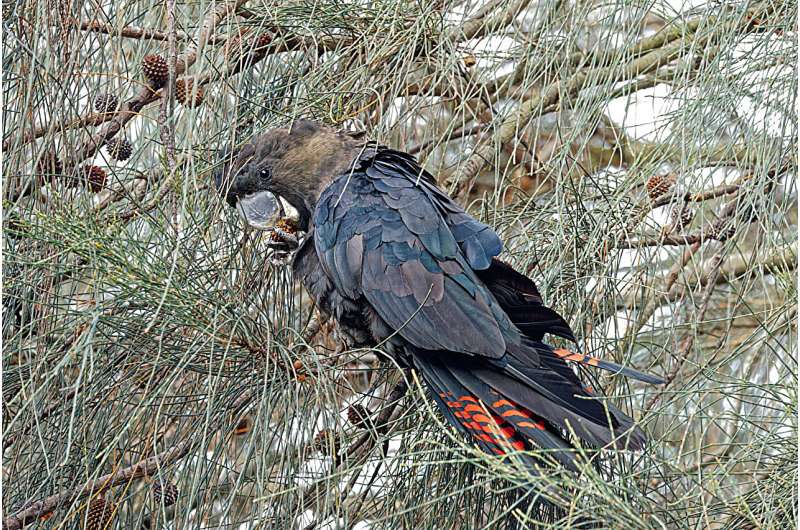This article has been reviewed according to Science X's editorial process and policies. Editors have highlighted the following attributes while ensuring the content's credibility:
fact-checked
peer-reviewed publication
trusted source
proofread
Research shows that glossy black-cockatoos prefer to feed from trees growing in acidic soils

Glossy black-cockatoos are seed-eating birds that feed almost exclusively on the cones of drooping sheoak trees. However, counter-intuitively, they select trees that grow on the poorest soils found on ancient sedimentary rocks.
"Sheoak trees are three times more likely to be used as feeding trees if they are growing on non-limestone sedimentary rocks," says Dr. Gay Crowley, from the University of Adelaide's School of Social Sciences.
Dr. Crowley compared 6,543 feeding records with 23,484 sheoak records from New South Wales to make this discovery. She found that soil type has a direct influence on the way glossy black-cockatoos use the environment by comparing glossy black-cockatoo feeding records with soils and rocks on Kangaroo Island.
"Sheoaks gain their nutrition through fungal associations, rather than from the soil, and their associated fungi thrive on poor soils," says Dr. Crowley, whose research is published in the journal PLOS ONE.
"Many iconic Australian animals, such as bilbies, potoroos, bettongs and bandicoots, feed directly on soil fungi – including native truffles. The same pathways are likely to be responsible for their distribution in the environment."
Glossy black-cockatoos are one of Australia's five species of black-cockatoos and can be found across eastern Australia as well as on Kangaroo Island in South Australia. The species is listed as endangered in South Australia, and as vulnerable throughout the rest of its distribution.
To ensure the long-term survival of species that depend on soil fungi, especially the glossy black-cockatoo, Dr. Crowley says conservation efforts need to consider the value of habitats on poor soils.
"Conservation efforts often prioritize the richest, most fertile parts of the landscape. This is because many rare animals, such as greater gliders and powerful owls, are most abundant in forests growing on rich soils derived from basalt or limestone," says Dr. Crowley.
"However, many other animals, such as potoroos, bandicoots, and glossy black-cockatoos may be best protected by preserving habitats on infertile soils."
More information: Gabriel M. Crowley et al, Geology controls the distribution of a seed-eating bird: Feeding-tree selection by the glossy black-cockatoo Calyptorhynchus lathami, PLOS ONE (2024). DOI: 10.1371/journal.pone.0308323
Journal information: PLoS ONE
Provided by University of Adelaide




















